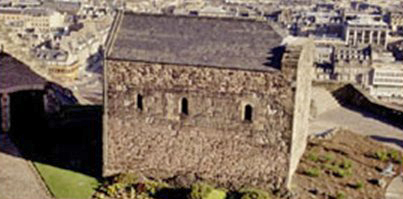|

Margaret of Scotland 1045-1093
|
|
Photo Above
Edinburgh Castle,
Scotland
Historic Scotland |
Margaretís father was
English, her mother German. Yet, Margaret became one of the most
famous women, a Saint even, in the history of the Scots who
ultimately honored her with a burial place at Edinburgh Castle.
How can you become this prominent in a foreign country?
Let's learn from Margaret.
It all started in the year 1045. Europe was still
quiet as the gunpowder hadnít been brought there yet. Ireland was
busy inventing handball, southern France checkers, and the Italians
carelessly started their building project in Pisa without inspecting
the foundation first.
Margaret was born a princess. One day her brother would succeed
Margaretís father to the crown of England. The only problem was that
her father wasnít king. The whole family lived in exile.
What had gone wrong?
Some decades before Margaretís birth, the Danish decided it was
their turn to rule England and overrun the country. Margaretís
grandfather and great-grandfather bravely opposed these strong
invaders but eventually had to submit to their rule.
As the local heir apparent, Margaretís father was sent from the
country and found exile, and later a wife, in Hungary. Thus Margaret
was born, brought up and educated at the Hungarian court.
Margaret was 12 years old when the family
thought it safe enough to
return back home. In 1057, they arrived back in England.
Things didnít develop much in Margaretís favor, however. Her father
died soon after their return and her brother was simply passed over
in the matter of throne inheritance.
There wasnít much time to think about all this though, as yet
another horde of foreigners already stood ready to become lords over
England. This time it was
 William the Conqueror and
his fellow Normans.
Margaret, now in her twenties, fled for protection to Scotland where
Malcolm III Canmore was king. William the Conqueror and
his fellow Normans.
Margaret, now in her twenties, fled for protection to Scotland where
Malcolm III Canmore was king.
Just like her father, Margaret found her spouse in the land of their
refuge. King Malcolm proposed to her and in 1070 the couple got
married in Dunfermline, 16 miles northwest of Edinburgh.
Margaretís husband Malcolm, a widower, knew about the heartache of
having to live in exile. He himself had to flee Scotland when he was
only 9 years of age and had to live in exile in England. The turning
point for Malcolm came at age 26. He found an opportunity to kill
Macbeth, the murderer of his father and current occupier of the
throne. Malcolm came back home to Scotland and continued the reign
of the nation just like his father Duncan did.
Supported by a husband who understood her lot, Margaret
rolled up her sleeves. Her activities over the next two decades would inspire the religious,
social, and political world of Scotland.
As a woman of class, Margaret brought a certain refinement to the
rather rough and rustic Scottish court. She increased the number of
the kingís attendants and had some suggestions with regards
to their way of dressing. She
also made a point of maintaining a certain style at the
kingís table. Fashion and manners mattered now and Scotland
made big eyes.
More importantly, Margaret cared about the poor and the pilgrims.
Margaret fed little orphan children, invited Benedictine monks to
Scotland, and founded churches, abbeys, hospitals and schools.
Under her leadership and with her husbandís backing, church councils
were held and the country was steered from their former Celtic way
of worship towards the Roman Catholic way of exercising faith.
In
only 23 years Margaret managed to re-shape the religion of the
entire Scottish nation.
Margaret was the mother of Edward, Edmund, Edgar, Ethelred,
Alexander, David, Matilda and Mary Ė eight children who became kings
of Scotland and Queens of England.
In November 1093 Margaretís husband Malcolm and her eldest son
Edward engaged in a battle with the Normans, who were then ruling
over England. Both men were slain near Alnwick, Northumberland.
Prince Edward was only 22 years old. Margaret died only three days
later at Edinburgh Castle, 47 years of age. Her physical condition
was already weakened by excessive abstinence and this bad news
delivered the final blow.
The royal couple was buried at Dunfermline, the very place where
they were wed.
As it often happens with true celebrities, real fame materialized after
death. How did it work in Margaretís case?
Thanks to Margaretís daughter Mary we are able to know quite a bit
about Margaretís life today. Mary asked a gentleman named
Turgot to
write her motherís biography. Turgot did a good job.
In 1250 the pope thought Margaret worthy of being canonized.
Hence she became known as Saint Margaret. Because of this
event, Margaretís buried bones were suddenly in high demand.
Even Mary Queen of Scots was said to have been in possession
of Margaretís head.
The tiny chapel in which Margaret worshiped when residing at
Edinburgh Castle is the oldest building in the castle and attracts
many visitors each year.

St Margaret's
Chapel, Edinburgh Castle
You're welcome to visit Edinburg
Castle today. You might even see a traditional Scottish
wedding with bagpipes and kilts.
More History
|